Behavior of Baupanel® System against hurricanes
The wind force acting on a construction has a magnitude proportional to the square of its speed. Thus winds of 100 km/h generates forces four times higher than winds of 50 km/h.
The Saffir-Simpson scale defines and classifies the category of a hurricane based on its wind speed. Category 1 is the least intense (winds of 119 to 153 km/h); Category 5 is the most intense (winds greater than 250 km/h). Category 4 hurricanes are considered very severe while those of category 5 are considered catastrophic.
As an example, Hurricane Mathew in Category 5, with sustained winds of 300 km/h, can generate a dynamic pressure equal to 434 Kg/m2.
This pressure is more than 8 times the maximum calculation of Spanish regulations in the windiest area of the Iberian Peninsula.
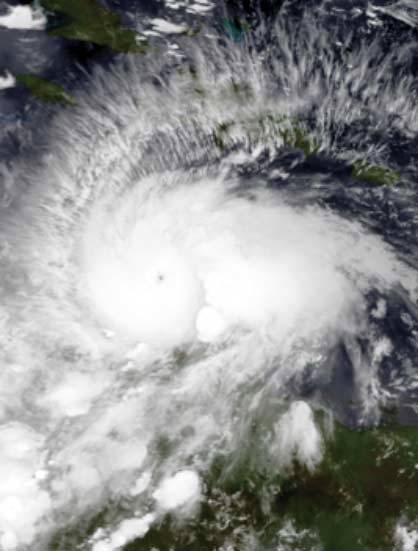
Hurricane Matthew, 2 Oct 2016
Buildings made with the Baupanel system have the capacity to withstand these enormous forces without the need for additional reinforcements of any kind.
In Antigua and Barbuda, houses with this construction technology have been built since 2014. Since then numerous cyclones and hurricanes have passed, among which we can highlight:
IRMA: 280 Km/h (Category 5) 05/09/2017
JERRY: 180 Km/h (Category 3) 18/09/2019
GONZALO: 230 Km/h (Category4) 16/10/2014
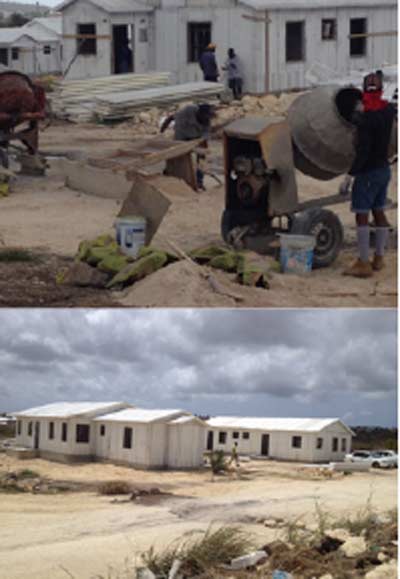
Housing construction in Antigua and Barbuda with Baupanel® System
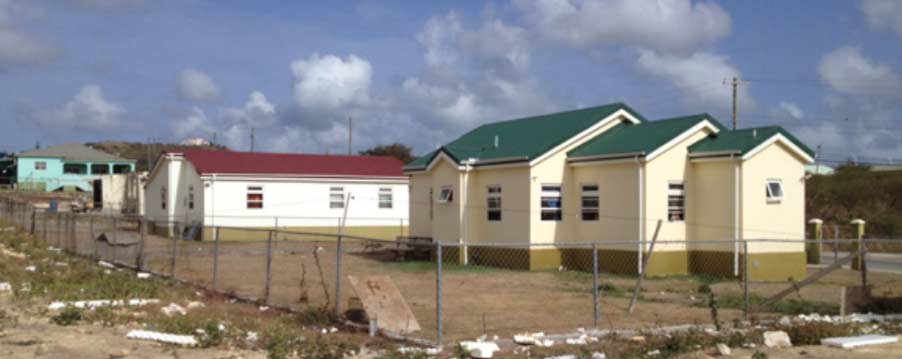
Finished homes in Antigua and Barbuda (2018)
None of the houses built with the Baupanel® System have suffered damages as a result of the passage of the hurricanes mentioned, while the constructions made with the traditional system have been seriously damaged or directly destroyed.
There are extremely interesting cases regarding the comparative effects of the passage of high-class hurricanes through areas where houses are made with panels in an urban plot of traditional homes, as illustrated in the following two images:
How can this extraordinary resistance be explained?
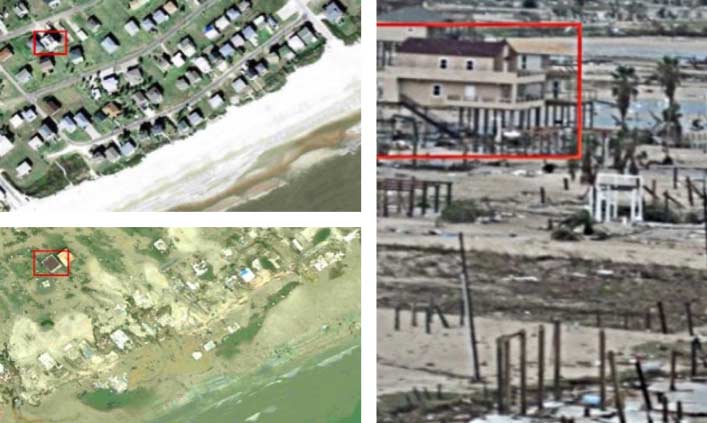
Aerial photographs of a home in Crystal Beach before and after Hurricane IKE, Bolivar Peninsula Texas USA (09/14/2008)
The dynamic wind force exerted on a dwelling is equal to the product of the wind exposure surface multiplied by the dynamic pressure value.
For the purpose of simplifying the calculation, modern wind regulations use a static pressure value equivalent to the dynamic wind pressure, using a multiplier coefficient that depends on several factors: shape, construction height, environment, etc.
For the purposes of this example we will assume that this coefficient reaches the value 1.25.
If we consider the dynamic pressure of 434 Kg/m2 generated by a hurricane with winds of 300 km/h, the value of the equivalent static pressure will be:
434 Kg/m2 x 1.25 = 543 Kg/m2
Hurricane resistance of the roof of a house
The roof of a house made with Baupanel® System panels, as well as the floors of the intermediate floors, are designed to resist the bending stresses derived from the acting gravitational loads (own weight + design overloads). These loads must be increased with the safety coefficients imposed by the construction regulations, finally reaching values close to 750 Kg/m2.
The wind force on the roofs of the houses is suction and a coefficient is applied to it, which we can normally consider is worth 0.8.
Then the effective suction on a cover will have the exact value of the dynamic pressure:
543 Kg/m2 x 0.8 = 434 Kg/m2
At this net suction the own weight must be discounted since this force will always act. Considering that the roof weighs about 200 Kg/m2, we will finally find that the net suction pressure will be the difference
434 – 200 = 234 Kg/m2
Since the panels have symmetrical reinforcements, they are qualified to resist upward and downward stresses of the same magnitude: 750 Kg/m2.
Having said all this, we conclude that all covers made with the Baupanel® System can withstand the suction efforts of hurricanes with a very important capacity reserve since to have a net suction equal to the load bearing capacity of the panel (750 Kg/m2) we should have a wind force more than 3 times higher.
Hurricane resistance of the facade walls of a house
The facade walls of a house must withstand wind stresses that resemble horizontal distributed loads whose magnitude is that of the equivalent static pressure.
For this, the walls will act with their flexural capacity in the same way as the roof slab. The actions in this case will be more intense since, unlike the roof, there are no forces of own weight to partially compensate for horizontal thrusts.
However, the order of magnitude of the ability to resist bending of these elements is quite similar to that of the slabs, with the additional advantage, that all interior walls, as well as those of perpendicular facades, will act as buttresses. This allows the bending calculation space to be reduced by the distance between these elements.
If we take the value of 750 Kg/m2 as a reference value, we will see that the ability to withstand a horizontal pressure of 543 Kg/m2 caused by winds of a speed of 300 km/h will be guaranteed.
These pressures will be transmitted to the foundation through all the perpendicular walls to which they receive the frontal action of the wind.
Behavior of the set of walls of a house in front of Hurricane Matthew in Category 5
If we consider to illustrate this example that we had a small house whose dimensions in plan were 3,375m x 9.00m and a height of 2.70m, the horizontal force that should resist in the direction of greater length would be equal to:
543 Kg/m2 x 9 m x 2.70 m = 13,195 Kg
And in the direction of shorter length:
543 Kg/m2 x 3,375 m x 2.70 m = 4,948 Kg
The total force will be distributed by the walls that are in the direction in which the wind acts.
Suppose that in the main direction there are 4 walls (2 exterior + 2 interior) and in the minor direction there are only 2 walls that would be those of the house’s facade.
In this case, each of the 4 walls parallel to the wind will support a quarter of the force of 13,195 Kg, that is:
F = 3,298 kg
To simulate this effect, a cyclic load test has been carried out at the Eduardo Torroja Institute in Madrid, subjecting two walls 3,375 m wide by 3,375 m high to a horizontal force as in the example cited. One of them presents a window while the other presents a door.
The force is placed on the head of the walls and acts on the basis of 2 dynamometers that exert symmetrical forces. The panels are mounted on a running shoe of normal dimensions for a house, and the joining of the panel to them has been carried out without any particular reinforcement different from the general specification of the construction system.
The maximum test load is reached with a value greater than 20,000 Kg
This value greatly exceeds the calculated value (F = 3,298 kg) of the effort that a hurricane like Matthew in category 5 with winds of 300 km/h would transmit to the walls to take the efforts to the foundation.
The failure of the test is caused not by breaking the wall, but by taking off the wall with the foundation.
This explains very clearly that the constructions made with Baupanel can withstand the devastating effects of hurricanes in the highest category.
To destroy the walls would require a force 6 times more powerful.
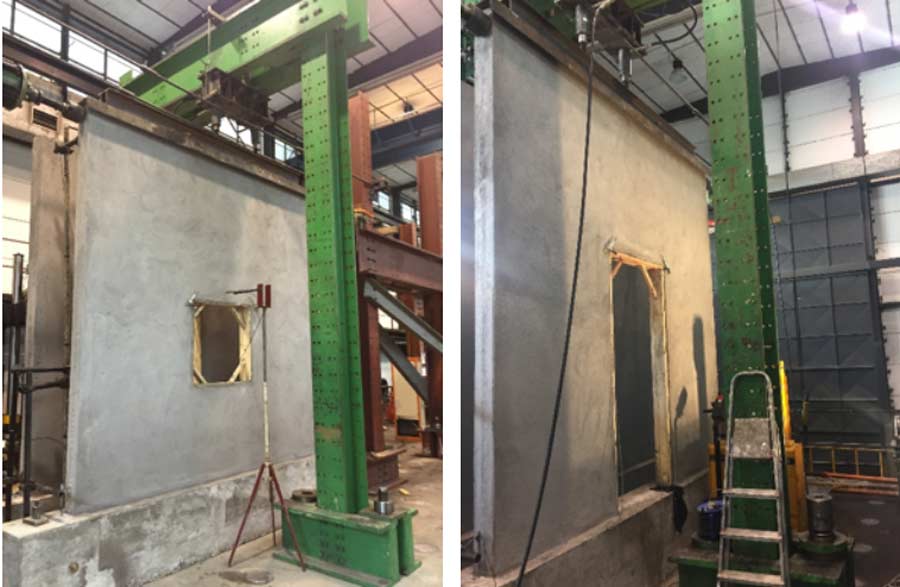
Cyclic loading test at Eduardo Torroja Institute 2016.
Impact resistance of hurricane-thrown objects
Hurricanes have the particularity of launching high-speed dismissals, various objects such as tree branches or various debris from affected homes.
These objects impact at very high speed and can cause damage, which although they are punctual, could have undesirable consequences for the safety of the inhabitants.
That is why in the United States there is a regulation to give aptitude to tornado shelters, which must pass a series of tests that consist of the launch of 2 x 4-inch and 15-pound wooden missiles at speeds of 80 and 100 mph, so that they impact the walls and verify the effects produced.
The trials were conducted at “The Wind Science and Engineering Research Center” – Texas Tech University, Lubbock, TX
The test criterion at a speed of 100 mph corresponds to a wind of 250 mph (402 km/h)
Hurricane Shelter Test Protocol 4: OVERCOME
The tornado missile hit the sample leaving a 2 x 4 inch imprint with a depth of 1 inch. There was no damage to the back of the panel.
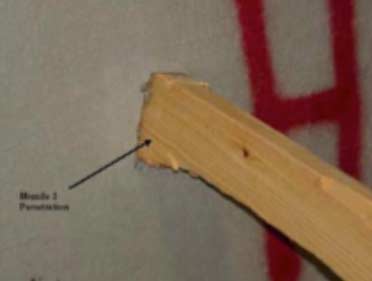
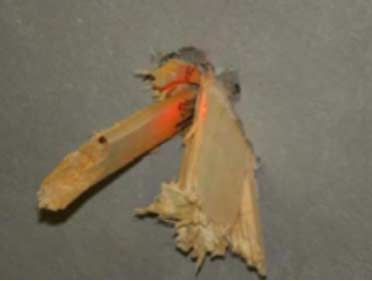
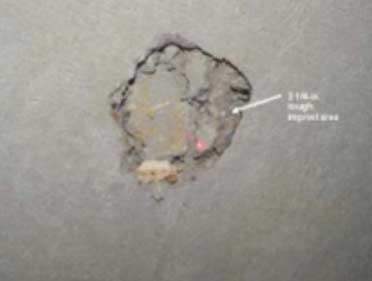
Details of the wood missile penetration imprint driven at 102mph.




